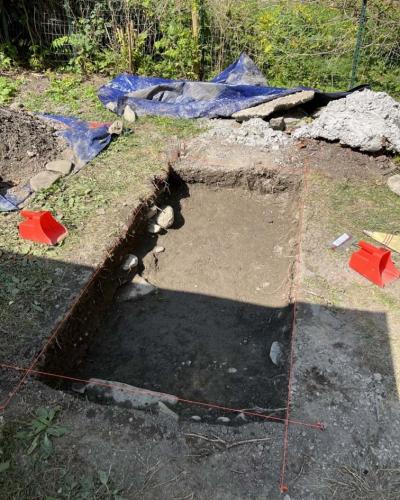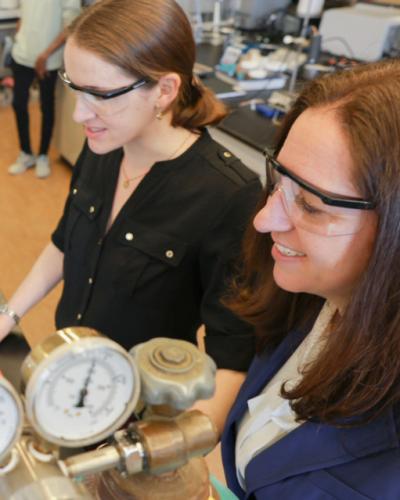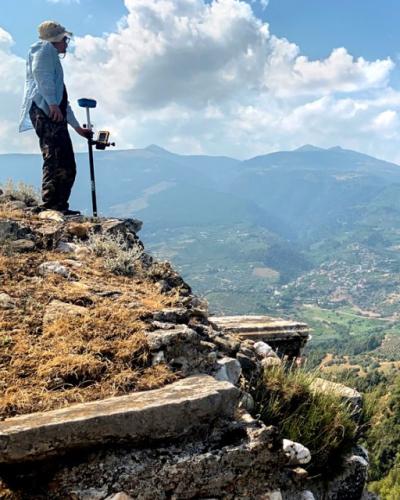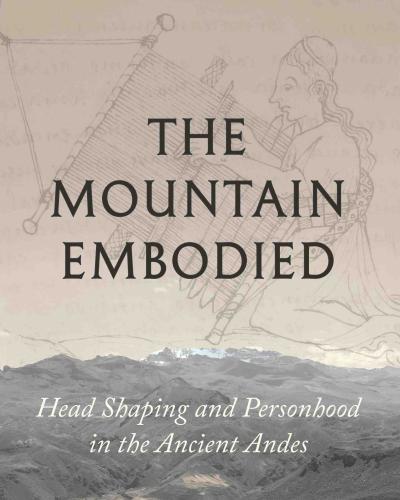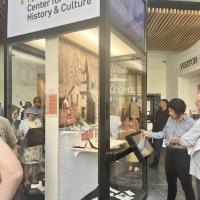I’m not a particularly religious person, but I’m struck by how the slow and deliberate act of moving my trowel across the dirt at the bottom of this 2x1 unit feels like a deeply spiritual act. I’ve worked in this unit before, with a rotating group of my academic peers and volunteers from Cornell and the larger community. We work for hours to bring the soil down, digging and screening as we go. During this process, I often remind myself that the land and soil are not static but spiritually and culturally charged facets of a larger landscape. I grew up Southern Baptist, and now I stand here in the garden of the St. James AME Zion Church, hoping to find something that connects the members of the congregation to those who came before.
Music drifts out into the garden from the sanctuary just above. I’m told that the choir is practicing, as they often do on Saturday mornings. I’m suddenly hit by the fact that we’re digging up remnants of life in the context of a spiritually active space. The actual digging has been slow at the bottom of unit seven, where I have worked two Saturdays in a row. We move our trowels through the dirt and fill buckets for screening. I love the methodological rhythm, interrupted intermittently when I’ve hit a rock or perhaps a fragment of something else. Oftentimes, exclamations are heard across the church garden when someone has a find to share.
Figure 1. Unit 7 at the beginning of the excavation season (photograph by author).
The past is something we too often take for granted. We employ it as a tool to show how far we’ve come. Outside of academic debate, we more likely view time as linear and traditions as “antiquated”. We ask the past what it can do for us. Rarely do we ask what we can do for the past. The past informs us, but it doesn’t ask us to be careful and considerate in sorting and defining historical artifacts. We had to learn this for ourselves, and it took a long time for our disciplinary forefathers and mothers to reach a point where research could be conducted carefully and ethically. Archaeologists are increasingly aware of the significance of the work they do and the land they do it on. Archaeology does not happen in an echo chamber; it has consequences for the larger community and the descendants of the cultures we study.
We can see land not only as geographical and political but also as something that is deeply connected to spirituality and spiritual practice. We know that land is not a neutral entity but something that we construct through our cultural and social identities. Religious identity heavily factors into the construction of the self and the spaces that we inhabit. Not everyone is religious, but perhaps, if you have your own sense of spirituality, you can relate to the process of creating a space that has qualities that bring you closer to a state of enlightenment or peace. The practice of “making” a space is a deliberate one. The land that St. James stands on is informed by its situating at the intersection of past and present.
As a stop on the underground railroad, St. James has strong ties to race politics of the past and bears the spiritual significance of being a place of worship for its current members. It’s also a structure that exists within the context of the local community. Members of the community are welcome at the site, to ask questions or experience archaeology at work. As St. James is an active spiritual space, it is a structure that community members know to approach with a certain degree of respect. This is, after all, a space that is utilized not only for worship but for important life events within the community. People get married here. They celebrate important milestones with one another as a spiritual community. We are here to supply the community with knowledge about the past, and it’s not a role that should be taken lightly. We are currently over halfway through the final season of excavation, and we’ve uncovered signifiers of a way of life that has evolved alongside the land and structure.
We are allowed to be on this land and do archaeological research because of the generosity of the clergy. They make space for us to exist alongside them as they participate in acts of worship such as choir practice or church events. The artifacts we find are not for our own benefit as archaeologists, though we are honored to participate in the process of knowledge production. This isn’t to say that we don’t form our own associations or get excited at the prospect of an interesting find.
When we find an object, we become deeply connected to the object’s history. It’s our role as archaeologists to do the personal history of an object justice. Artifacts have associations from before we came into contact with them. We must consider the spiritual lives of the things themselves before transforming them with our academic influence. Many of the items found in trenches at St. James have a rich history tied to manufacture, use, reuse, and disposal. Whether these objects were inherently “religious” or not, we can say that their lives and uses were informed by their existence in this religious space.
We can attribute lives and meanings to things by employing a sort of spiritual animism. Animism is essentially the belief that all things have a spiritual essence. No “thing” is static. I think our work at any site, but especially active spiritual sites, requires the belief that the objects themselves are imbued with a spiritual quality. Alongside sherds of whiteware and shards of glass, we find complete articles such as buttons, bones from small animals, and other things more indicative of lifestyles. These objects, independent of original contexts, are still active in many ways. From the moment we find an artifact, it enters an entirely new context. The objects allow the past and present to form a concrete relationship, and that fact has powerful implications. If we view the soil at the church as having spiritual significance, we must consider that the objects found within the soil are spiritual beings in themselves.
We return to the past for guidance. We view it through the context of memories and objects that have perhaps been left behind or long forgotten. Ultimately, we should view St. James as a space rich with memory. Memory isn’t limited to what living people can tell us. Spaces hold memories. This can also be seen in the context of spirituality or ritual behavior. Oral histories play a large role in the work we do, and so do material histories. The marks in the wood of the building itself or the makers’ marks we can see on some of the wares found during excavations are indicative of a material memory. We seek out artifacts as a means of knowing the past because they bore witness to it. Some of our findings were perhaps touched by people long gone, with the lives those people gave them still somehow attached. We can’t always access those associations, but we’re increasingly aware of their presence.
We haven’t always considered objects as active participants in history. In fact, we haven’t always considered every person an equal and active participant in history. This is a weakness that was sewn into archaeology at its inception. Archaeology has a past in itself that is fraught with cultural insensitivity. The importance of projects that involve the larger community and the employment of active spaces is that they allow archaeology to move away from the prejudice often associated with conducting this work in isolation.
St. James is an active religious space more than it is an archaeological site. Yes, you can walk into the church and see artifact cases with some of the findings from the project. However, it’s important to remember that this is a place where people come to be spiritually fulfilled.
Standing in the garden and listening to the choir practice, I feel a deep respect for the history and life of the church itself. Each member of the congregation has a relationship to the structure and the land. We operate in a space of ongoing spiritual significance. Occasionally, we see members of the church. They walk onto the dig site and ask about our findings. More than members of a church congregation, they are potential stakeholders in the work that we do. Perhaps, they are more likely to understand the spiritual and cultural significance of findings on a deep and personal level.
Figure 2. St. James in the early twentieth century (photograph by Seth Sheldon, History Center, ca 1904).
St. James is deeply tied to the community’s identity both as a religious structure and as a stop on the underground railroad. The work we do here is impactful in the spiritual sense as well as the political. African American spirituality is an important avenue for studying the connections between culture, race, colonialism, and religion. We can think of the process of meaning-making as an especially sensitive topic in doing an archaeology of the spiritual, especially when applied to marginalized groups.
Archaeologists are situated between the culture they are studying and the cultural perspective that informs them in an everyday sense. I come into this project with a very specific background. As do my peers and the numerous volunteers working at the site. I believe that the best part of community archaeology is learning how the distinct cultures and interests of my fellow archaeologists inform their readings of the landscape and the artifacts.
Something we must always consider is that the landscape and artifacts have significance outside of how we view and think of them. While working in unit eight, I found a very small piece of a reddish-purple glass. This piece was perhaps part of a larger work of stained glass. We can think of each piece of glass not only as part of an original vessel or structure but as indicative of a choice by an artist. The pieces themselves, in the absence of associated pieces, cease to be defined as parts of a whole once they’ve become artifacts.
Stained glass is a material element that arose in religious practice as a reflection of the idea that light operates as a spiritual conduit. The glass elements we find at St. James are not always pieces of stained glass that would have been used in the original windows of the church. However, the fact that we can find pieces of stained glass in the soil calls attention to a spiritual history. The St. James AME Zion Church is a living structure, meaning that it has evolved and continues to evolve as part of the community landscape. We, as archaeologists, are always thinking about the past of the structures and landscapes we work within. This might be the most important aspect of working in a spiritual space such as St. James.
This may be the last season for excavations at St. James at this point in time, but there will continue to be community projects and projects that occur at spiritually active places. It’s up to us, as archaeologists, to remember that spirituality is an important facet in the lives of the people we study and their descendant communities and that artifacts themselves have spiritual associations.

